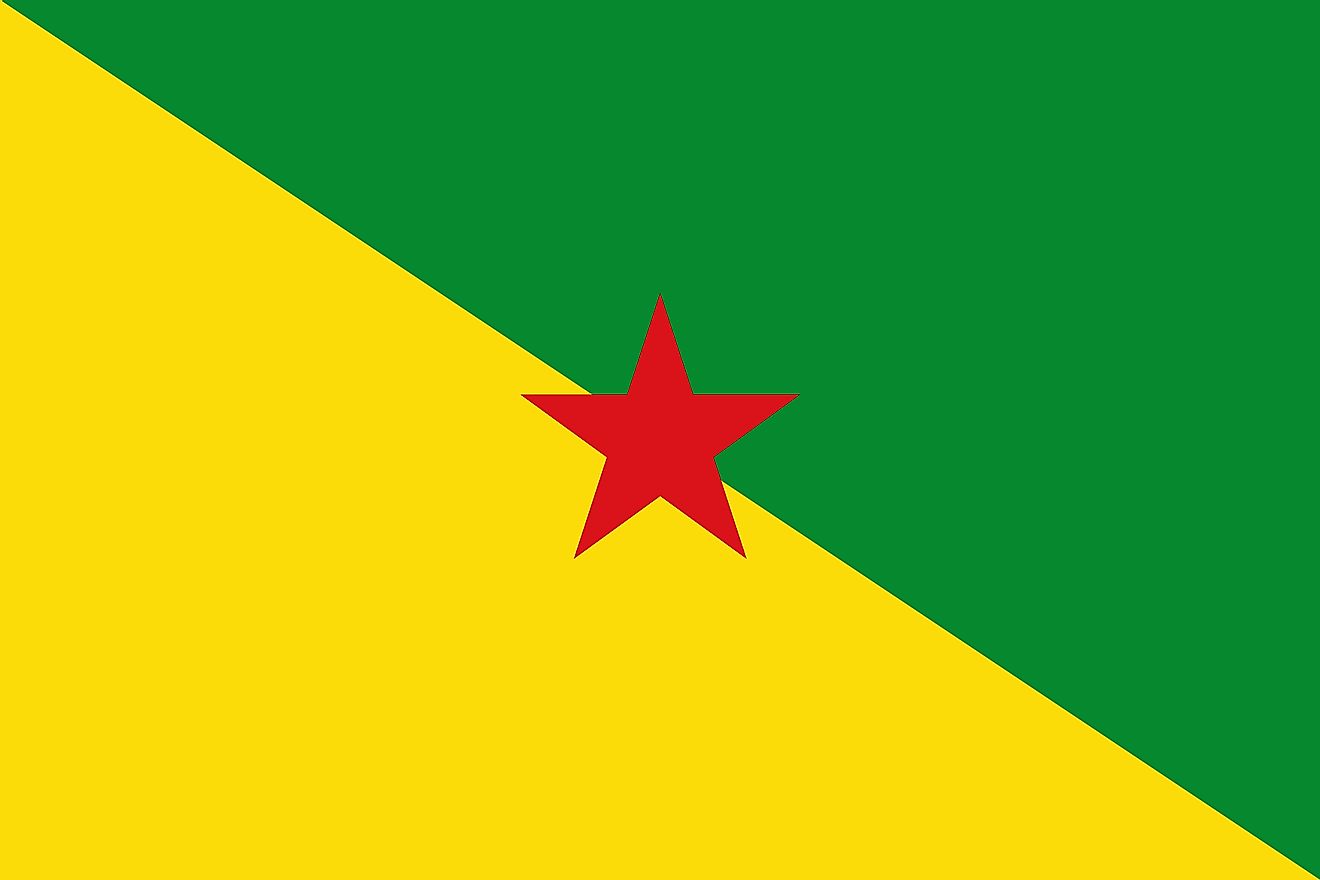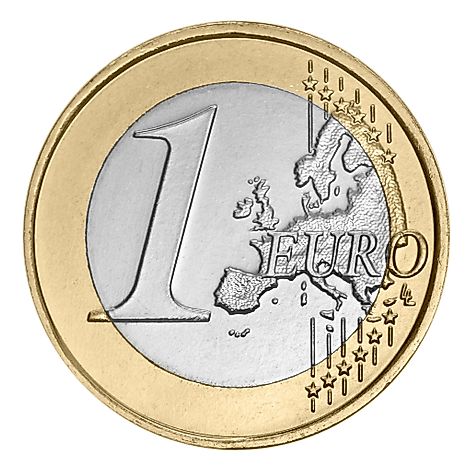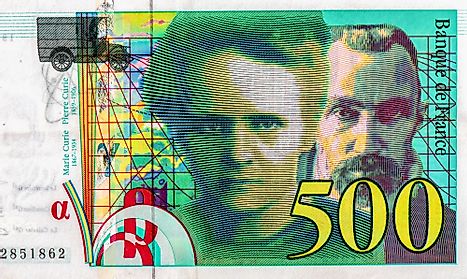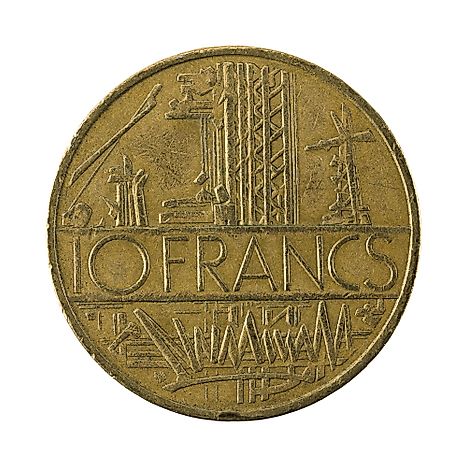Flags, Symbols, & Currencies of French Guiana

French Guiana is an overseas department of France, and therefore flies the flag of France.The French national flag - the tricolore - consists of three vertical bands of equal width, displaying the country's national colors: blue, white and red. The blue band is positioned nearest the flag-staff, the white in the middle, and the red on the outside. The red and blue colors are Paris’ traditional colors, with blue associated with St. Martin and red with St. Denis. The two colors are also associated with the Virgin Mary, France’s patroness. Occasionally, the colors are used to represent the revolutionary motto: Liberty, Equality, and brotherhood. However, according to the government website, blue and red are the colors of Paris while white was the color of the king. The flag of France is 1.5 times wider than the height.
Besides the national flag, the regional governmnt use regional flags. However, the official regional flag depends on who you talk to. The Regional Council in French Guiana declare the white flag with the silhouette as their regional flag. The Departmental Council adopted the green and yellow flag as the official regional flag of French Guiana. The French Guiana football team uses the green and yellow flag.
History of the French Guiana Flag
French Guiana was originally inhabited by the Native American people, including Arawak and Kalina. The French first attempted to settle in the area in 1624, but were repelled by the Portuguese. However, the French returned in 1630 and formed settlement in Cayene, making the long journey to French Guiana becaming an overseas department of France. As an overseas department and region of France no other flag was flown on the island except the French tricolor flag. Thus, French flag is the only officially recognized flag of French Guiana.
Symbols of French Guiana
National Coat of Arms of French Guiana

The coat of arms of French Guiana is also the country's national symbol. It is a shield consisting a boat with oars carrying gold. The boat is positioned in an green river with three white water lily flowers. The heavily laden boat represents the richness that exists in the territory. The top of the Coat of Arms is a blue strip with three fleurs-de-lis beneath the number 1643. The number 1643 refers to the year that the French founded the Cayenne City. Two anteaters, one on either side of the shield, are guarding the coat of arms.
National Anthem
- Anthem Title: La Marseillaise (The Marseillaise)
- Music composer and Lyricist: Claude Joseph Rouget de Lisle
- Date of Adoption: 1646
Being an integral part of France, the French national anthem is used in French Guiana as the official anthem. Claude Joseph Rouget de Lisle composed La Marseillaise in 1792 while in Strasbourg immediately after France declared war with Austria. He titled the song “Chant de guerre pour l'Armée du Rhin" (War Song for the Army of the Rhine). Three years later, the song was adopted as the Republic’s national anthem by the French National Convention.
La Marseillaise
Allons enfants de la Patrie,
Le jour de gloire est arrivé !
Contre nous de la tyrannie
L'étendard sanglant est levé, (bis)
Entendez-vous dans les campagnes
Mugir ces féroces soldats ?
Ils viennent jusque dans vos bras
Égorger vos fils, vos compagnes !
Aux armes, citoyens,
Formez vos bataillons,
Marchons, marchons !
Qu'un sang impur
Abreuve nos sillons !
Que veut cette horde d'esclaves,
De traîtres, de rois conjurés ?
Pour qui ces ignobles entraves,
Ces fers dès longtemps préparés ? (bis)
Français, pour nous, ah! quel outrage
Quels transports il doit exciter !
C'est nous qu'on ose méditer
De rendre à l'antique esclavage !
Aux armes, citoyens...
Quoi ! des cohortes étrangères
Feraient la loi dans nos foyers !
Quoi ! Ces phalanges mercenaires
Terrasseraient nos fiers guerriers ! (bis)
Grand Dieu! Par des mains enchaînées
Nos fronts sous le joug se ploieraient
De vils despotes deviendraient
Les maîtres de nos destinées !
Aux armes, citoyens...
Tremblez, tyrans et vous perfides
L'opprobre de tous les partis,
Tremblez ! vos projets parricides
Vont enfin recevoir leurs prix ! (bis)
Tout est soldat pour vous combattre,
S'ils tombent, nos jeunes héros,
La terre en produit de nouveaux,
Contre vous tout prêts à se battre !
Aux armes, citoyens...
Français, en guerriers magnanimes,
Portez ou retenez vos coups !
Épargnez ces tristes victimes,
À regret s'armant contre nous. (bis)
Mais ces despotes sanguinaires,
Mais ces complices de Bouillé,
Tous ces tigres qui, sans pitié,
Déchirent le sein de leur mère !
Aux armes, citoyens...
Amour sacré de la Patrie,
Conduis, soutiens nos bras vengeurs
Liberté, Liberté chérie,
Combats avec tes défenseurs ! (bis)
Sous nos drapeaux que la victoire
Accoure à tes mâles accents,
Que tes ennemis expirants
Voient ton triomphe et notre gloire !
Aux armes, citoyens...
The Marseillaise
Arise, children of the Fatherland,
The day of glory has arrived!
Against us, tyranny's
Bloody standard is raised, (repeat)
Do you hear, in the countryside,
The roar of those ferocious soldiers?
They're coming right into your arms
To cut the throats of your sons, your women!
To arms, citizens,
Form your battalions,
Let's march, let's march!
Let an impure blood
Water our furrows!
What does this horde of slaves,
Of traitors and conspiring kings want?
For whom have these vile chains,
These irons, been long prepared? (repeat)
Frenchmen, for us, ah! What outrage
What furious action it must arouse!
It is to us they dare plan
A return to the old slavery!
To arms, citizens...
What! Foreign cohorts
Would make the law in our homes!
What! These mercenary phalanxes
Would strike down our proud warriors! (repeat)
Great God! By chained hands
Our brows would yield under the yoke!
Vile despots would themselves become
The masters of our destinies!
To arms, citizens...
Tremble, tyrants and you traitors
The shame of all parties,
Tremble! Your parricidal schemes
Will finally receive their prize! (repeat)
Everyone is a soldier to combat you,
If they fall, our young heroes,
Will be produced anew from the ground,
Ready to fight against you!
To arms, citizens...
Frenchmen, as magnanimous warriors,
Bear or hold back your blows!
Spare those sorry victims,
For regretfully arming against us. (repeat)
But these bloodthirsty despots,
These accomplices of Bouillé,
All these tigers who mercilessly
Tear apart their mother's breast!
To arms, citizens...
Sacred love of the Fatherland,
Lead, support our avenging arms
Liberty, cherished Liberty,
Fight with thy defenders! (repeat)
Under our flags may victory
Hurry to thy manly accents,
So that thy expiring enemies
See thy triumph and our glory!
To arms, citizens...
The Currency of French Guiana is the Euro
As an overseas department and region of France, the French Guiana is part of the Eurozone and uses euro as its currency. The region adopted the euro in 2002, the year France adopted the currency.
Coins
The euro is divided into euro cents, with 100 cents as the smallest denomination. Euro coins are available in several denominations, including 1c, 2c, 5c, 10c, 20, 50c, €1, and €2. All the coins have similar features, with the only difference being the denomination.
Banknotes
Euro banknotes have similar designs on both sides and are issued in the denomination of €5, €10, €20, €50, €100, € 200, and €500. However, each note has its color, with each dedicated to an artistic period in the history of European architecture. Other features include gateways or windows on observe and bridges on the reverse side.
Historical Currencies of French Guiana
Until 2002, French Guiana used French franc as its currency. Franc was used alongside other banknotes issued for French Guiana from 1888 to 1961 and notes issued for French Antilles. Franc was used until the France and its overseas deparments and regions like French Guiana adopted the use of the euro in 2002.















